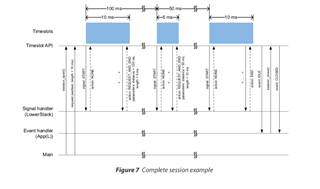I am developing a hand-arm vibration sensor for read-out via BLE
Development platform NRF51822 and S110
I'd like advice on how to configure the softdevice and the two wire bus to enable periodic measurements at a 1ms time interval
The application requires a sequence of measurements at fixed 1ms repeat interval over a duration of a few seconds. Each measurement requires a read over the two wire bus
I want to synchronize the two wire read with the softdevice operations so both play nicely together
The S110 v2 softdevice manual shows examples of timeslot usage (Page 25 sect 9.7.1 Fig 7
 )
)
https://infocenter.nordicsemi.com/topic/struct_nrf51/struct/s110.html?cp=4_7_0
How can I sequence timeslots at regular intervals?
How do I ensure that the read of the two wire bus occurs within the period of the timeslot?
What is the maximum length of slot?
What is the best way to hibernate softdevice operations for a period of ~1-2s?
Many thanks for any guidance. Most helpful would be any steers on how to adapt the two wire and HRM BLE examples in the SDK.
Cheers
Rob


